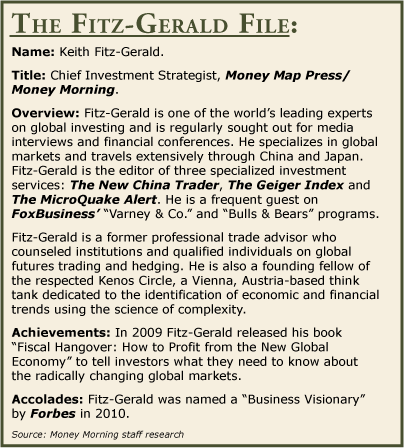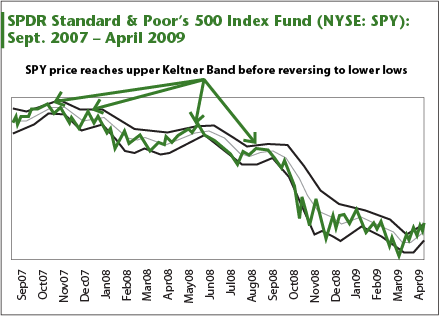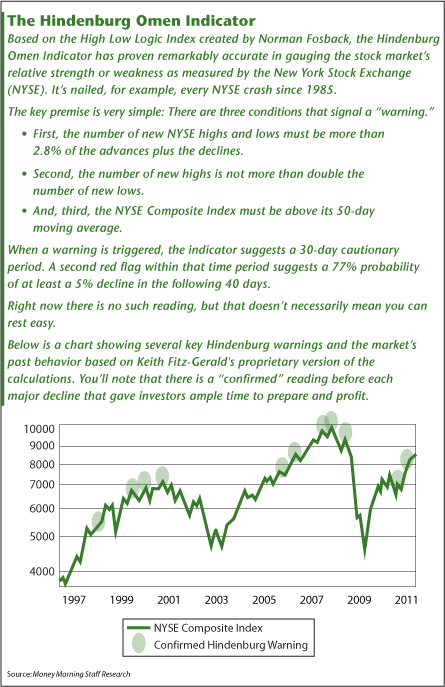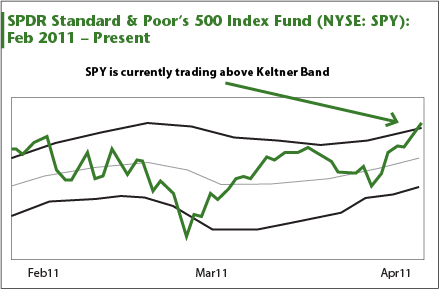In a stunning display of determination (or simple greed), U.S. stock prices are once again at new highs - despite problems in the Middle East, out-of-control government deficits throughout the world, an increasingly inflated China and the looming end to the U.S. Federal Reserve's free-money boondoggle, otherwise known as "QE2."
Should you be worried about a stock-market reversal?
I know that I am.
But here's the thing: While there's no question that a stock-market breakdown could derail the best of investing intentions, it doesn't have to derail your financial future. More to the point, if you understand when stock-market "turning points" are likely to occur, you can establish positions or trades ahead of time that will yield profits when those expected transitions actually come to pass.
Anticipating a Stock-Market Reversal
For example, knowing that a stock-market reversal may be in the cards allows you to tighten up your trailing stops as a means of protecting hard earned profits. Similarly, knowing that a potential turning point is forming can be a powerful signal to ready your "shopping list" of things you want to buy, because dips and periodic pullbacks make great (and highly profitable) buying opportunities.
I'm not advising you to try and "time" the market - study after study underscores what a bad idea that is - but I am telling you to be opportunistic.
And there's a difference.
By being opportunistic, I'm advising you to take steps to understand the stock market's ebbs and flows - and then using that understanding in ways that help you preserve your wealth and capitalize on opportunity when it knocks.
And if that stock-market reversal never comes to pass, that's fine, too - at least you're thinking strategically about your investments, have set up potential profit opportunities, and are prepared for any number of contingencies.
So where are we now?

At this point in earnings season, we're looking back at nine consecutive quarters of growth. We're also seeing a shift in sentiment, as even some of the most strident of pessimists become optimists. And last but not least, we're also watching with a mixture of hope and worry as the U.S. central bank gets ready to withdraw QE2 - an act that will rob the markets of the trillions of dollars in cheap money to which it's become addicted.
Commodities continue to rally and the U.S. dollar continues to fall.
And, unbelievably, still the markets rally. The Standard & Poor's 500 Index, the Dow Jones Industrial Average and the Nasdaq Composite Index are all up substantially off their March 2009 lows: As of Thursday's close, the S&P 500 is up 101.96%, the Dow 94.94%, and the Nasdaq is up 126.42%.
Three Indicators to Watch
But there are some worrisome signs. For instance, many investors have grown overly bullish. They seem determined to cheer on the market bull and, even more worrying, to ignore anything that could remotely interfere with their hopes for riches or dreams of wealth.
The bottom line: They're no longer paying attention to reality.
So where are we right now? Let's look at three indicators I like to follow:
- The "Keltner Bands."
- The "Hindenburg Omen Indicator."
- And the "R-squared" indicator.
We'll start with the Keltner Bands.
Market Insights From the "Keltner Bands"
First publicized in 1960 by Charles W. Keltner in his book, "How to Make Money in Commodities," Keltner Bands identify volatility around the trend rather than volatility around price, which is what their more widely recognized "cousin," the Bollinger Bands, do.
Consequently, they can help you identify situations of relative overvaluation, or undervaluation, especially if prices have moved above or below "normal" price ranges.
Typically comprised of three lines - a trend and two lines representing the upper and lower boundaries of "normal" volatility - the Keltner-Band indicator is surprisingly easy to read.
Here's an example showing the SPDR S&P 500 Exchange Traded Fund (NYSE: SPY) that may help.

Right now, the price is slightly near the upper boundary of normal price movement. This suggests to me that a stock-market reversal is possible if for no other reason than prices are a little "rich."

Beware of the Hindenburg Omen Indicator
As descriptive as the name sounds, the Hindenburg Omen Indicator is one of my favorites, although many investors may not be aware of it.
Based on the High Low Logic Index created by Norman Fosback, the Hindenburg Omen has proven remarkably accurate in gauging the stock market's relative strength or weakness, as measured by the New York Stock Exchange.
For instance, the Hindenburg Omen has nailed every NYSE crash since 1985.
The key premise is very simple: There are three conditions that, when met, signal a "warning":
- First, the number of NYSE new highs and lows must be more than 2.8% of the advances plus the declines.
- Second, the number of new highs cannot be more than twice the number of new lows.
- And, third, the NYSE composite must be above its 50-day moving average.
When a warning is triggered, the indicator suggests a 30-day cautionary period. A secondary reading within that time period suggests a 77% probability of at least a 5% decline in the following 40 days.
Here's an info-graphic that illustrates several key Hindenburg warnings along with the market's past behavior based on my proprietary version of the calculations. You'll note that there is a "confirmed" reading before each major decline (designated by the shaded regions), which gave investors ample time to prepare and profit prior to the actual stock-market reversal.
At the present time there is no reading. But the lack of a "Hindenburg" warning should not be taken as a signal that you can rest easy. Not right now.

The Artful R-Squared Indicator
The R-squared indicator is a statistical measure taught in basic statistics classes the world over. In a nutshell, it's used to gauge just how good one data series is at predicting the values associated with another. For instance, if the R-squared reading is 1.0, then academics would say you can perfectly predict the second data series' behavior. If it is a 0.0, then the one data series cannot be used at all to model the second.
When it comes to investing, I like to prepare for stock-market reversals or pullbacks when the trend is up and the R-squared reading exceeds 0.80 and is rising. If the trend is down, I'll start loading up on stocks I want to buy as the reading again approaches 0.80.
Right now, the R-squared reading is 0.22 and rising which suggests, from a mathematical perspective, that the rally is more likely to continue than it is to fail.
Moves to Make Now
In closing, two of the three technical indicators I most prefer to use - I'm speaking here about the Keltner Bands and the R-Squared indicator - are flashing "yellow," which suggests that caution is in order. So is a little preparation.
Here's what I suggest:
- Move your trailing stops higher across all asset classes and get ready to take profits if there is a stock-market reversal and stock prices break down.
- Consider establishing positions that profit from short-term declines, including the purchase of "put" options on the indices or on specific stocks; also consider the purchase of specialized "inverse funds" that actually rise when everything else falls.
- Get ready to buy. Many of the trends the markets are ignoring right now are not going away, even though a short-term reversal in the markets may cause many investors to lose their nerve. Short-duration bond funds, energy shares, and "glocal" companies are all good choices at the moment. [Editor's Note: A "glocal" stock is a term that Fitz-Gerald uses to describe large, U.S.-based multinational corporations whose global operations include a local presence - especially in the crucial markets of China and Greater Asia. Most of these companies are publicly traded, and have their shares listed on the S&P 500 stock index.]
In closing, I've got one more sure-fire indicator to think about.
Knowing that the herd is almost inevitably wrong at major stock-market turning points, I tend to get very nervous when I hear stories about the last-remaining pessimists shifting over to the optimists' camp - just as perma-bear and notable curmudgeon David Rosenberg, chief economist at Gluskin Sheff & Associates Inc. (PINK: GLUSF), did recently.
News and Related Story Links:
- Amazon.com:
How To Make Money In Commodities. - Investopedia:
Keltner Channel. - Wikipedia:
Bollinger Bands. - Investopedia:
Be Aware of the Hindenberg Omen Indicator. - Airships.net:
The Hindenburg. - Bloomberg News:
`Hindenburg Omen' Indicator Suggests Slump in Stocks: Technical Analysis. - Tucker Report:
R-Squared. - Business News Network:
Gluskin's Rosenberg bullish on energy stocks.
About the Author
Keith is a seasoned market analyst and professional trader with more than 37 years of global experience. He is one of very few experts to correctly see both the dot.bomb crisis and the ongoing financial crisis coming ahead of time - and one of even fewer to help millions of investors around the world successfully navigate them both. Forbes hailed him as a "Market Visionary." He is a regular on FOX Business News and Yahoo! Finance, and his observations have been featured in Bloomberg, The Wall Street Journal, WIRED, and MarketWatch. Keith previously led The Money Map Report, Money Map's flagship newsletter, as Chief Investment Strategist, from 20007 to 2020. Keith holds a BS in management and finance from Skidmore College and an MS in international finance (with a focus on Japanese business science) from Chaminade University. He regularly travels the world in search of investment opportunities others don't yet see or understand.



